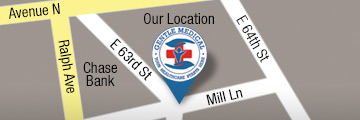Medical Treatment For Your Sprains and Strains
Posted by admin on September 13th, 2013

“Sprains and strains can be very painful. When treated properly, the swelling and pain should diminish quickly. However, doing too much too soon may result in reinjury. It can be difficult initially to tell the difference between a bad sprain and a fracture, in which case it may be necessary to seek a professional opinion”.
-Dr. Zimilevich, MD
Sprains and strains- what is the difference?
Although the terms sound similar, sprains and strains are not the same. A sprain involves injury to the ligaments that connect bones together at the joint, while a strain is an injury to a tendon or muscle. The most common sprain is the ankle sprain, while back injuries are a common form of muscle strain.
What are the signs and symptoms of sprains and strains?
If you experience a sprain, you will notice bruising, swelling, pain and a limited ability to move the affected joint. You may feel (or even hear) a loud “pop” when the injury occurs.
If you sustain a strain injury, you may notice swelling, pain and a limited ability to move the affected muscle. You may experience painful muscle spasms.
What causes sprains and strains?
A sprain occurs when you overextend your ligament while placing stress on the joint. The tendon may actually tear. A strain occurs when the muscle is stretched beyond its normal capacity. Strains may be acute or chronic. While acute strains occur suddenly, usually as the result of a single event or moment, acute strains may occur when a muscle is strained repetitively.
Who is at risk of suffering a sprain or strain?
If you are in poor condition and stress your ligaments or muscles beyond what they are capable of, you may injure them. If you are in good condition but fail to warm up your muscles adequately before engaging in physical activity, you may experience an injury. Becoming overly fatigued may also result in injury as you are less likely to protect your joints. Sometimes sprains and strains are the result of an accident that can’t be prevented.
How do I know if I need to come see you?
If you are unable to walk without a great deal of pain, or you cannot bear any weight on the affected joint, you need to come in and see me. If you have numbness in the injured area or you cannot move the affected joint, it is important to have you injury evaluated.
What can I expect when I come in to see you?
When you come in to see me, I will first gather a little history about you, including your past medical history, medications you are taking and any allergies to medications you may have.
Next, I will need you to tell me how the injury occurred. I will need to know what you were doing when the injury occurred (playing a sport, shoveling the sidewalk). How long have you had the pain? Have you ever injured the same area before? Did you hear or feel any noises when the injury occurred? The answers to these questions can provide me with some clues to help make the diagnosis.
I will then examine the affected area, looking for bruising, swelling and pain with gentle manipulation of the joint, as well as range of motion. After I have examined the joint, I will determine whether the area needs to be x-rayed to complete my evaluation.
How do you treat sprains and strains?
Treating a sprain or strain involves RICE:
- Rest- rest the affected area
- Ice- apply ice to the area for 10 to 15 minutes 3 times/day
- Compression- wrap the area with an ace bandage (support bandage), being careful not to wrap the area too tightly
- E– elevate the affected area if possible above the level of your heart to decrease swelling (i.e. put your ankle up on a chair while you are sitting)

Over-the-counter analgesics such as ibuprofen or Tylenol can be used as directed for pain. Crutches may be necessary for severe ankle or knee sprains.
If you are unable to work due to your injury, I can provide you with a note for work. If you injured yourself on the job and your injury is a Workman’s compensation claim, please let my office staff know prior to your visit so that we can help you complete the appropriate paperwork.
If you have suffered a sprain or a strain and you are unable to walk or bear weight, or you experience numbness in the area, make an appointment to see me urgently. In most cases, you can be seen on an urgent basis. Make your appointment today.
Our Location

6301 Mill Lane, Brooklyn, NY 11234.
(718) 942-4600



